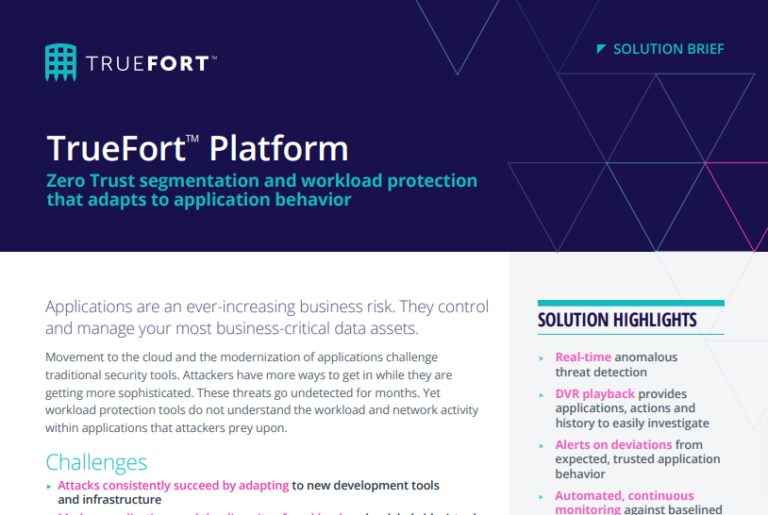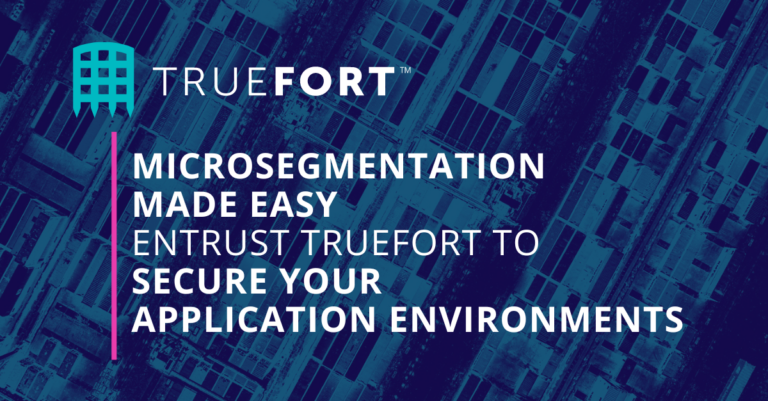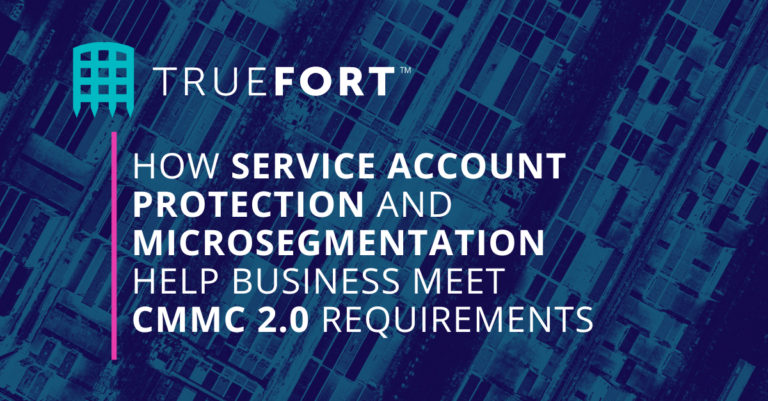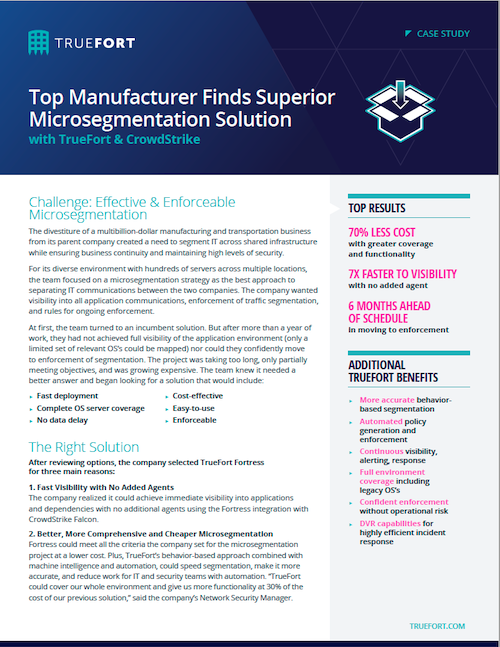TRUEFORT SOLUTION
Zero Trust best practices with the TrueFort Platform
Microsegmentation is Zero Trust best practices. It is essential in today’s dynamic, hybrid environments to protect necessary traffic at the application and workload level. Zero Trust policies limit lateral movement and isolate workloads for the best possible security posture, and TrueFort microsegmentation advances the industry-recognized Zero Trust approach.
Why adopting Zero Trust is so important
- Security: It is inevitable that attackers will breach perimeter defenses. Whether ransomware, insider threats, or other cyberattacks, a Zero Trust approach, using microsegmentation, can prevent attackers from expanding through lateral communications and stolen credentials.
- Compliance: Many IT standards require critical data to be segmented from general network traffic, such as PCI DSS or HIPAA, or region-specific requirements, such as GDPR. The TrueFort approach to Zero Trust offers reassurance and compliance, as standard.
- IoT/IT/OT: Zero Trust secures IoT, IT, and OT systems from lateral movement attacks. Microsegmentation isolates critical business applications from unmanaged, vulnerable devices.
- Business standards: Businesses may need to separate workload communications by geography, function, or line of business for divestiture or other business needs. Zero Trust means zero friction.
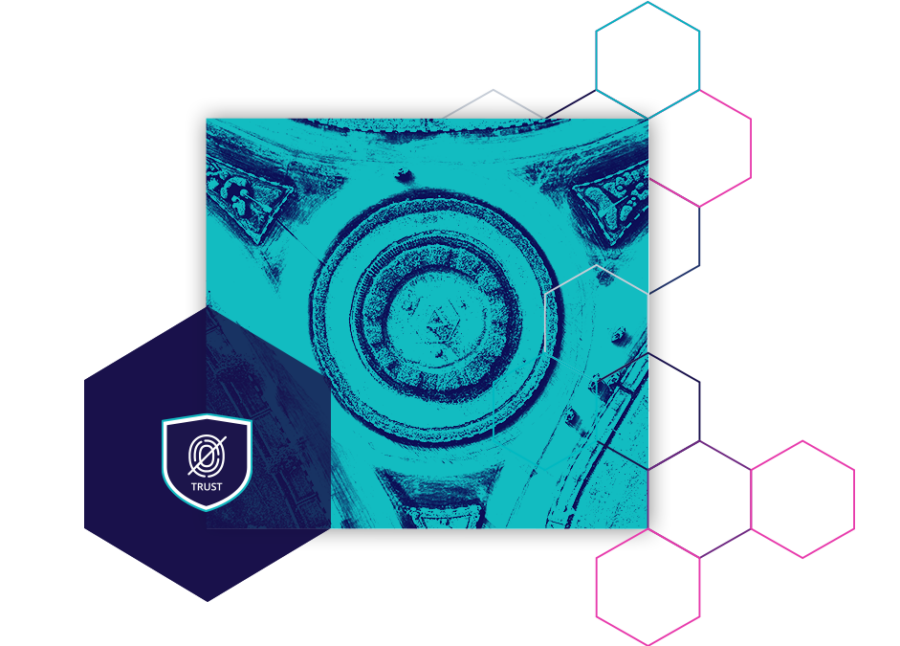
Zero Trust architectures require an intelligent approach to microsegmentation
Best Practice Zero Trust
Lateral movement protection and microsegmentation and the workload level, easily conforming to NIST and CMMC recommendations.
Real-time Application Telemetry
The TrueFort Platform offers real-time application behavior analytics with visualized maps for communication flows, enabling detection of unexpected behaviors.
Visibility and Control
Zero Trust microsegmentation = advanced threat protection. TrueFort forces granular policies and gives visibility of workload and app behavior.
Protecting IoT Environments
Segment IoT to cut industry attack surface. Microsegmentation for Zero Trust. TrueFort gives vital visibility on IoT links.
FAQ
Zero Trust security is a security framework that assumes that all users, devices, and network traffic are untrusted and must be verified before gaining access to resources.
This model operates on the principle of “never trust, always verify” to ensure the security of data, devices, and resources. Zero Trust security prevents the spread of cyber-attacks by implementing strict access controls, continuous monitoring, and risk-based authentication. It requires implementing multifactor authentication, network segmentation, and granular access controls. With Zero Trust security, access to resources is granted on a need-to-know basis, and every request is authenticated and authorized before being granted, even when the access was already granted to other workloads on the same network.
The Zero Trust approach helps organizations to protect sensitive data, applications, and systems from internal and external threats, even if a breach occurs. Zero Trust is an effective security model that provides an additional layer of protection for organizations against cyberattacks.
Zero trust architecture is a solution that assumes all users, devices, and network traffic are untrusted and must be verified before gaining access to resources. It requires the implementation of strict access controls, continuous monitoring, and risk-based authentication to ensure the security of data and resources. Zero Trust architecture prevents cyber-attacks by implementing multifactor authentication, network segmentation, and granular access controls.
There are six pillars of zero trust architecture:
- User: Here, zero trust architecture focuses on user identification, authentication, and access control policies which verify user attempts to connect to the network using dynamic and contextual data analysis.
- Device: Zero trust architecture for devices performs “system of record” validation of user-controlled and autonomous devices to determine acceptable cybersecurity posture and trustworthiness.
- Network: Network architecture for zero trust isolates sensitive resources from being accessed by unauthorized people or things by dynamically defining network access, deploying micro-segmentation techniques, and controlling network flows while encrypting end-to-end traffic.
- Infrastructure: This ensures systems and services within a workload are protected against unintended and unauthorized access and potential vulnerabilities.
- Application: This integrates user, device, and data components to secure access at the application layer. Security wraps each workload and container to prevent data collection, unauthorized access, or tampering with sensitive applications and services.
- Data: This involves focusing on securing and enforcing access to data based on the data’s categorization and classification to isolate the data from everyone except those that need access.
This approach helps organizations to protect sensitive data, applications, and systems from internal and external threats, even if a breach occurs. Zero Trust architecture grants access to resources on a need-to-know basis, and every request is authenticated and authorized before being granted. This model effectively reduces the attack surface and minimizes the risk of data breaches, making it a popular choice among organizations that prioritize security. In summary, Zero Trust architecture is a security model that helps organizations to implement strict access controls, continuous monitoring, and risk-based authentication to protect against cyber-attacks.
To implement zero trust, organizations need to follow a series of steps.
- Firstly, they must identify and classify all the resources and data they want to protect.
- Second, when implementing zero trust they need to create a network map to understand how and by which resources are accessed.
- Third, they must implement strict access controls, including multifactor authentication, network segmentation, and granular access controls.
- Next, during zero trust implementation, they must continuously monitor and analyze network traffic to identify and mitigate potential security threats.
- Finally, organizations need to regularly update their security policies and procedures to ensure that they remain effective against emerging threats and attackers.
By following these steps, organizations can implement a zero trust security model that helps to protect their sensitive data and resources from cyber-attacks.
Zero trust security is built on a few core principles.
- Organizations should never trust anything inside or outside of their network.
- Organizations should verify all users, devices, and network traffic before granting access to resources.
- A core principle of zero trust is to adopt a least-privileged access model to limit access to resources on a need-to-know basis.
- Organizations should monitor and analyze network traffic to detect and mitigate potential security threats.
- Organizations should use strong authentication methods, such as multifactor authentication, to verify user identities.
- Finally, those adopting the principles of zero trust should encrypt data in transit and at rest to protect it from unauthorized access.
Organizations can protect their sensitive data and resources from cyber-attacks by following these core principles of zero trust.
There are six main benefits of zero trust security for organizations.
- Zero trust helps to reduce the attack surface by limiting access to resources on a need-to-know basis.
- Zero trust improves the visibility and control of network traffic, making it easier to detect and mitigate potential security threats.
- A major benefit of zero trust is that it helps to prevent lateral movement by segmenting the network, microsegmenting applications and workloads, and limiting access to resources.
- Zero trust provides a strong defense against insider threats by implementing strict access controls and monitoring network traffic.
- It supports compliance with data protection regulations by encrypting sensitive data in transit and at rest.
- Finally, it enhances the overall security posture by continuously monitoring and improving security policies and procedures.
Through the implementation of a zero trust security model, organizations get the benefit of significantly reducing the risk of cyberattacks and protecting their sensitive data and resources.
The three concepts of zero trust security are:
- Verify explicitly: All users, devices, applications, and network traffic are considered untrustworthy and must be verified before being granted access to resources.
- Enforce least privilege access: Access to resources is granted on a need-to-know basis, and users are only granted the minimum level of access required to perform their tasks.
- Assume breach: Organizations should operate under the assumption that their network has already been breached and implement measures to minimize the impact of any potential security incidents.
By adhering to these three concepts of zero trust, organizations can implement a zero trust security model that provides strong protection against cyber threats and minimizes the risk of data breaches.
Resources
